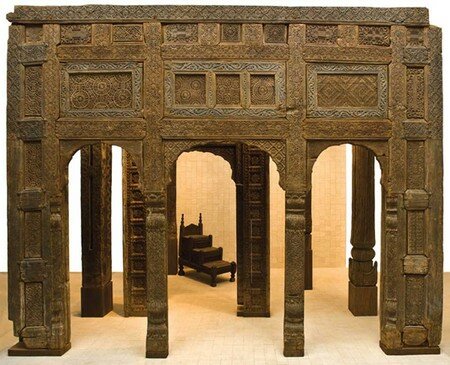"L'Art Islamique dans les collections belges" aux Musées Royaux d'Art et d'Hitoire de Bruxelles
Wood, architectural elements from a mosque in Swat (North-West Pakistan). XVIIth-XXth centuries. Pine, mulberry and cedar wood.
BRUSSELS.-The Royal Museums of Art and History present a new exhibition space that presents over 300 treasures of Islamic art. This imposing room (54 x 14 x 6 m) is an extension of the temporary exhibition entitled «Art of Islam in the Belgian collections», organized for the Cinquantenaire from 5 December 2003 to 25 April 2004, that had allowed the Royal Museums of Art and History to show their riches in this field. A survey carried out among the public and the guides of the educational and cultural services contributed to define precisely the concept of the room. In a new, splendid venue, designed by architects Anne Pire and Jan Goots, it hosts 340 of the 1200 objects from the collection (not to mention the thousands of shards from Fustat and the nearly 200 weapons momentarily stored at the Musée de l'Armée).
These objects, carefully selected and especially restored for this event, cover a wide territory, from Southern Spain up to Northern India. The most famous ensemble is the one of the textiles, made up for the greater part from the donation and bequest of Isabella Errera (1869-1929). It includes above all the Egyptian textiles from the beginning of the Islamic period and, among its masterpieces, a linen qamis (shirt with silk embroidery) dated between 1150 and 1230. Then come the Andaluzan and Sicilian silks, among them a superb Sicilian weaved-tapestry from the XIth-XIIth century with gold silk threads; Turk silk weaved cloths (with, in particular, a fragment from the çatma, probably the most ancient Turkish velour in the world) then the Iranian textiles and those from central Asia, with its lampas that look like miniatures. (courtesy www.artdaily.com)

/https%3A%2F%2Fprofilepics.canalblog.com%2Fprofilepics%2F1%2F0%2F100183.jpg)
/https%3A%2F%2Fstorage.canalblog.com%2F03%2F02%2F119589%2F96711876_o.jpg)
/https%3A%2F%2Fstorage.canalblog.com%2F11%2F31%2F119589%2F94773502_o.jpg)
/https%3A%2F%2Fstorage.canalblog.com%2F20%2F83%2F119589%2F94772815_o.jpg)
/https%3A%2F%2Fstorage.canalblog.com%2F26%2F72%2F119589%2F75604929_o.jpg)
/https%3A%2F%2Fstorage.canalblog.com%2F59%2F60%2F119589%2F26458628_o.jpg)



/image%2F1371349%2F20240519%2Fob_583448_337c830007d041432f6c96b9124d51a4171399.jpeg)
/image%2F1371349%2F20240519%2Fob_3e418f_444764941-1672252233544789-80815166057.jpg)
/image%2F1371349%2F20240519%2Fob_53b164_444444730-1672274996875846-76060439427.jpg)
/image%2F1371349%2F20240519%2Fob_e6afcc_444790548-1672879040148775-35488405222.jpg)